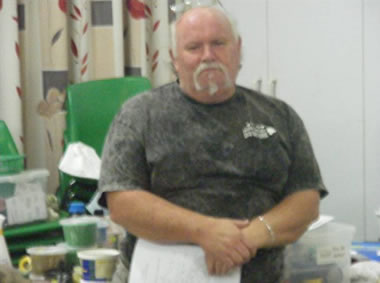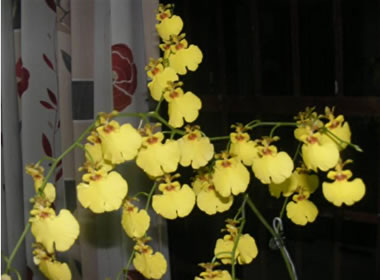Orchid News – May 2011
Home > Orchid News > 2011
Index
Calendar
- 29, 30 Apr, 1 May – Autumn Show at Botanic Gardens
- 5 May Neutrog – Chemicals
- 2 Jun Ivy – Taiwan Orchid Show
- 16 July 40th Anniversary Luncheon
- 21 July – Dick Cooper on Judging
May Meeting
Our guest speaker at the May meeting is from Neutrog Fertilisers. They supply fertilisers to a range of commercial and domestic growers. Their website is www.neutrog.com.au and you can check out their products there.
And a reminder to all our growers that it’s good practice to try any new product on a few plants to see how it works for you in your conditions before you apply it to all your collection.
40th Anniversary Luncheon
I would like to confirm that we have booked the Novotel for our 40th Anniversary luncheon. Tickets will be $25 each with the rest of the costs subsidised by the society.
Tickets are available from Ed, Bruce and Sherill, and we need to let the Novotel know definite numbers by 9th July, so please buy your tickets asap.
Show
Our Autumn Show is this weekend at the Botanic Gardens, with our display open from Friday to Sunday. Thanks to those who have volunteered to help supervise, sell raffle tickets, etc – there is a roster that you can check at the show, or call me on 0418 519908 if you have forgotten when you are on duty.
We would like to encourage everyone to bring along a few plants for the Show, even if you think your plants aren’t likely to win a prize.
And a reminder that there will be a sales bench operating so if you have any plants that you want to sell bring them along. These plants must be in flower or in bud.
Bereavement
We are sorry to learn of Bernie Hoffman’s death last weekend. Bernie was a long time member of Coffs Harbour Orchid Society and a member of other societies too. Bernie was very knowledgeable about orchids and was always ready to share his knowledge with other orchid growers. We have passed on our sympathy to his family.
The funeral will be at 2 p.m. on Friday in the Urunga Catholic Church, Pilot Street, Urunga.
On a brighter note Gordon Clark is home after a period in hospital. He is recovering well after serious illness.

Gordon Clark
Workshop
Any members who were attending the workshops held at Gordon Clark’s are welcome to call Gordon for advice about fertilising, or any other orchid growing matter on 6654 2553.
He is happy to talk with people, and can have a few visitors at home.
Supper
Thanks to everyone who brought some supper for the last meeting. It was good to see such a good spread.
Talk by Orchid Tray Company
George and Michael came along tonight as part of their show and tell to let us in on all the tools and supplies they have available to do with Orchids.
They are contactable by phone and email.
Between them they have over 9,000 orchids and reckon to be an expert you must have killed about a 1,000
They don’t consider themselves experts but are working on it. They realise that everyone does Orchid growing slightly differently but they just love passing on what they themselves have discovered. They use 98% of everything they sell so it is tried and tested.

George Bliss talking to us at our April Meeting
They have tried to keep their products reasonably priced and their wares included pots of different varieties, trays, fertilisers, pest controls, potting mixes (barks in different gauges’ and mosses), tags, tools, sprayers and misters, stem clips, hangers, drams Moisture meters.
They highly recommended a hose system which is combined with Magamp as their plants have thrived on it.
It was an interesting evening and would have given us all a good look at all that is available. It was handy to be able to stock up on much needed supplies.
Tentative Program for 2011
- 3 Feb Steve Clemesha talking about Phaius
- 3 Mar Ed Pearce – What is an Orchid?
- 7 Apr Orchid Tray Company – Orchid growing
- 29, 30 Ap, 1 May Autumn Show at Botanic Gardens
- 5 May Neutrogena – Fertilisers, etc
- 2 Jun Ivy Wheeler – Taiwan Orchid Trip
- 16 Jul 40th Anniversary Luncheon
- 21 Jul Dick Cooper – judging
- 4 Aug Doug Binns – terrestrial orchids
- 1 Sep Eric Collins – Soft cane Dendrobiums
- 9, 10, 11 Sep Spring Show at Botanic Gardens
- 13 Oct Plant Auction.
- 3 Nov AGM. Brian Newman – Catasetums.
- 1 Dec Christmas meeting and awards.
Agenda for May 2011 Meeting
Welcome, Apologies, Visitors.
Minutes of April meeting – see newsletter
Business Arising?
Committee Report – see newsletter
Inwards Correspondence
- Grafton Orchid Society show – 6th, 7th, 8th of May2
- Woolgoolga Orchid Society show – Saturday 8th October- set up Friday afternoon our support would be much appreciated.3
- Bellinger Valley Orchid society show – Saturday 18th August – set up from 7pm Friday the 17th and Saturday morning before 7.30am. The Uniting church Hall Cnr Hyde & Ford St. Bellingen. Judging will commence at 8am and show will open from 10am to 4pm.
- Letter from Friends of the North Coast Regional Botanic Gardens Inc. informing us that the kitchen (due to safety issues) is now off limits to all except the café staff.
- Certificate of investment from BCU.
- Bank Statement from BCU.
Outwards Correspondence
- Sympathy card to Hoffman family
Finance Report – see newsletter
Sponsors Spot – BCU.
Table talk.
General Business
- 40th Anniversary Luncheon
- Autumn Show.
Guest speaker.
Raffle, popular vote.
Minutes for April 2010 Meeting
Apologies – Peter Baker, Eric & Dot, Diane, Bernie Hoffman, Pam & Graham Bailey,
Minutes of February Meeting – Mvd, Sue Scd, Steve
Business Arising – 40th Anniversary– To be held at Novotel 16th July, Tickets sold up to week before event at $25 each. The Orchid Society will be subsidising the tickets.
Inwards Correspondence
- BCU Cheque Book
- Xerox Centre – Statement and Invoice
- BCU Term deposit update
- BCU Sponsorship will continue
- Port Macquarie Orchid & Bromeliad – Show 6th May to 8th May
- Orchids Out West Show– Hawkesbury Racecourse Clarendon 20th May to 22nd May
- Geebung Gazette
- Neutrog – Newsletter and donation of gardening book ‘From the ground up” for members to borrow
- Newsletter from Australian Orchid Foundation
- Maclean District Orchid Society – Show 29th April to 30th April (Maclean Bowling Club)
- City of Lismore Orchid Society Inc – Show 14th April to 16th April at Lismore Centro Shopping centre
- Coffs Harbour Orchid Society – Show 29th April to 1st May- Benching 6.00pm to 8.00pm 28th April and 7:30 – 9.00am 29th April – At the Botanical Gardens.
Outward Correspondence
- Get-well Card to Gordon Clarke
- Show Schedules to neighbouring societies
Mvd. Betty Scd. Ivy
Finance Report Mvd. Don Scd. Betty
Sponsors Spot. Mangrove Jacks and BCU have each donated $150 to continue sponsoring us.
Table Talk – Norm
General Business
Autumn Show information, Ring Ivy Wheeler if any help needed (6653 4229)
- Ensure the name of the plant is on the card and your name is on the back. Blue-Tac will be available to stick these to your pots.
- We will be setting up at 5pm on 28th April and 7 – 7:30 on Friday morning.
- Judging will be held at 8:00am Friday morning.
- Please phone Ed Pearce if you are available to go on the roster to help with raffles and sales etc.
- Labelling will be the same as the monthly meeting.
Guest Speaker
Raffle, Barbara Hunt, Steve Newman,
Popular Vote – Sue Williams

Sue William’s lovely Oncidium which won the popular vote for the night.
Committee Report
The April committee meeting was held at Don Turner’s. The main items discussed were the upcoming show, and the 40th Anniversary luncheon.
Orchid Virus Diseases
Here is an article about orchid virus from the Berowra and District Orchid Society. We reprint it with permission.
Some growers know a lot about this, others know very little. People are urged not to panic about virus, but the article again stresses the importance of good plant hygiene with our orchids. Here is the article by Jim Brydie.

Cattleya with mosaic virus
In about 2004, an excellent article titled “Can You Cure Virus Diseases in Orchids” appeared in the Maitland and Coalfields District Orchid Bulletin. I don’t know who wrote it but these first paragraphs are most important:
We used to hear that virus could be eliminated from a valuable clone by tissue culture of the meristematic tissue. The theory was that the cells in the meristem tissue (i.e. the growing tip of the shoot) were dividing so quickly, they stayed ahead of the virus infection spreading from behind but there is divided opinion on whether this actually works and even if it does, as plants have no immune system, there is no cure whatsoever for virus in the infected orchid itself.
It is an interesting side issue that orchid seed is not affected by virus, so it is possible to breed with an infected orchid. One must remember though, that if the pod is on an infected plant, the pod tissue itself is infected, and that special precautions must be taken when sowing the seed. For example, the pod could be allowed to split naturally, and the clean seed spilled onto a sterile surface. Where green pod sowing is employed, I believe it is not unknown to find that all seedlings in the flasks are found to be infected.
Symptoms – So how do we know if our own orchids are infected? What are the symptoms of virus? It is an unfortunate fact that some orchids may be infected with a virus (including CMV and ORSV) without showing any visible symptoms. Most however, do show distinct and typical physical symptoms under most conditions. The worst effect though, is that infected plants are weakened by the virus. They do not grow as strongly, or flower as well as a clean plant, and the flowers usually don’t last as long. In some cases, infected Cattleya flowers can begin to collapse in just days. The weakened condition of the plant can also lead to secondary bacterial and fungal infections and this may even mask the viral presence, making the identification of a virus problem very difficult. The only reliable method to identify a virus infected orchid is a laboratory test but all orchid growers should be familiar with the symptoms commonly seen and that is where I hope we can help.
Over 50 different virus diseases have been identified in orchids. Clearly however, the two most common, and therefore of most concern to orchid growers, are Cymbidium Mosaic Virus (CMV), and Tobacco Strain “O” Virus which is often called Odontoglossum Ring Spot Virus (or ORSV).”
CMV and ORSV are by far the two orchid viruses we hear most discussed. They have been the main focus of commercially available laboratory testing, and also in purchasable home testing kits. Symptoms can vary, but orchids with CMV usually show streaking and mottling in broken lines of lighter green in the leaf especially in developing new leaves. Plants with ORSV may show a distinct, roughly circular spot, that is an outer ring of necrotic (dead) black tissue with some green tissue inside and then a necrotic black spot in the centre. ORSV is also often called colour break virus because the flowers, may be marked with irregular colour patterns, especially in the Cattleya alliance, like the flower at the right. Pictures of typical leaf symptoms of both viruses are shown below.
Other Viruses – Although CMV and ORSV tend to dominate discussions, the other 50 odd viruses can’t be ignored. The following two sections are from an excellent article by Graham Corbin on the Brisbane Orchid Society web site. They help illustrate how complex it is for even an experienced grower to tell you which virus your orchid might have.
“Flec Virus” – The Cymbidium and Brassia can both have Orchid Flec Virus. The symmetrical markings and the yellow rectangular spots with distinct edges on the Cymbidium are classic symptoms of this virus although the symptoms can easily be confused with CMV. The Brassia Rex also has Orchid Flec Virus but shows quite different symptoms. It has a strong necrotic (i.e. dead cell) ring pattern.”

Virus in Cymbidium leaf.
“Rhabdovirus” – The symptoms are the necrotic spots on the leaves. The white marks are a fungicide and not a symptom. Contra to commonly believed folklore, the new leaves of this orchid were perfectly clean and showed no necrotic spots or any other symptoms as they developed.
One thing I have noticed that may help distinguish virus from other marks on your orchids, is that virus symptoms tend to go right through the leaf. When in doubt however, get the orchid tested.”
Virus Prevention – Virus is only transmitted from one plant to another through infected sap. As plants don’t sneeze, this can only happen through:
- the action of sap sucking or tissue chewing insects;
- sap transferred by plants rubbing against one another;
- water drips from an infected plant landing on a non infected plant; or
- man
Please don’t think that orchid virus isn’t an issue for you. EVERY orchid collection has some virused plants, even mine. Virus can come in on new plants, on insects from neighbouring homes, or even from rubbing up against infected plants at shows. Some of your current orchids might even be carriers that show no easy symptoms. Other than laboratory testing every plant in your collection, I know no way to identify a sleeper. You just have to be vigilant.
Sterilising secateurs and cutting implements – “TRICLEANIUM” is the product I recommend that you use for sterilising your secateurs etc. It is a pre-painting product, like sugar soap, made for washing down walls before you paint. You will usually find it in the paint section of hardware stores. It dissolves in water to make a strongly alkaline solution that destroys organic materials on the cutting blades but doesn’t damage the steel of the blades like bleach and some other products can do. It doesn’t burn your skin like bleach does either. Tools can just be left sitting in the Tricleanium permanently, and it doesn’t matter if you get it on your hands. Just don’t suck your fingers.
You use Tricleanium as a saturated solution. In something like a 15cm jam jar, that only takes about two heaped teaspoons of the Tricleanium crystals, but add enough so there are some un-dissolved crystals in the bottom of the jar. Depending on how much sterilising work it is put to, the jar of solution is good for a month or two. When it becomes too discoloured, or there is debris gathering in the bottom, clean out the jar and make up a fresh solution. A large 750gm container of Tricleanium which costs about $12-$14 will last you for many years. It’s cheap.
Tricleanium takes at least 5 minutes to sterilize a pair of secateurs, perhaps longer if you didn’t wipe them before putting them in to sterilize. Physically wiping your secateurs removes excess organic material from the blade and prolongs the life of the solution.
For practical purposes, I have three pairs of identical secateurs, all sitting in the jar at the same time. After using the pair in the front, I wipe them and put them in the back, then use the next front pair for the next plant etc. That way, it is probably more like half an hour before I need to use the first pair again, and I always have sterilised tools.
Conclusion – More and more growers are becoming quite sophisticated about their knowledge of orchid viruses and how to assess visual symptoms. Laboratory testing is already commercially available for a moderate cost (i.e. – in the order of $15 to $20), and home testing kits cost about $10 per test for CMV and ORSV. These costs are likely to reduce as we do more and more testing, and when you consider that a flowering size piece of a decent orchid costs between $30 and $200, even today’s costs are justifiable. Testing will surely increase in coming years. Growers who ignore virus and regularly present infected plants will become known, and will have a problem on their hands.
Can you afford to not pay attention? You must at least sterilize your cutting implements and if you aren’t already in the habit, please start now. And also, don’t forget to wash your hands between plants.
(Jim B.)

Rhabdovirus infected plant
